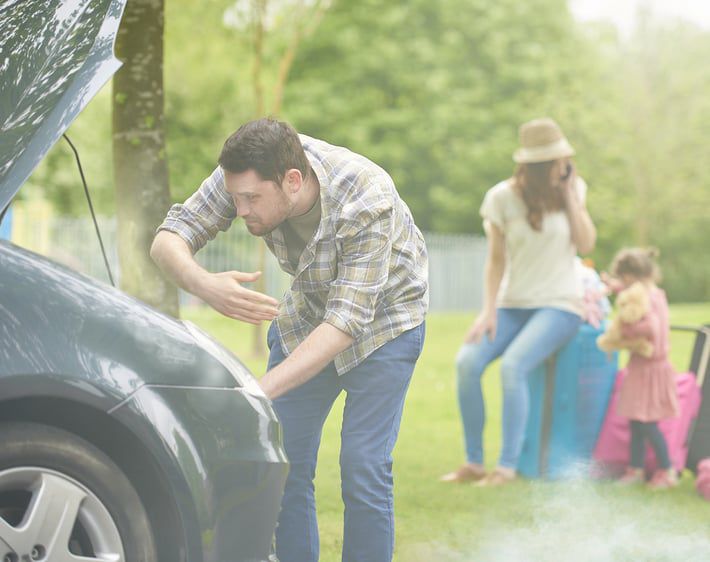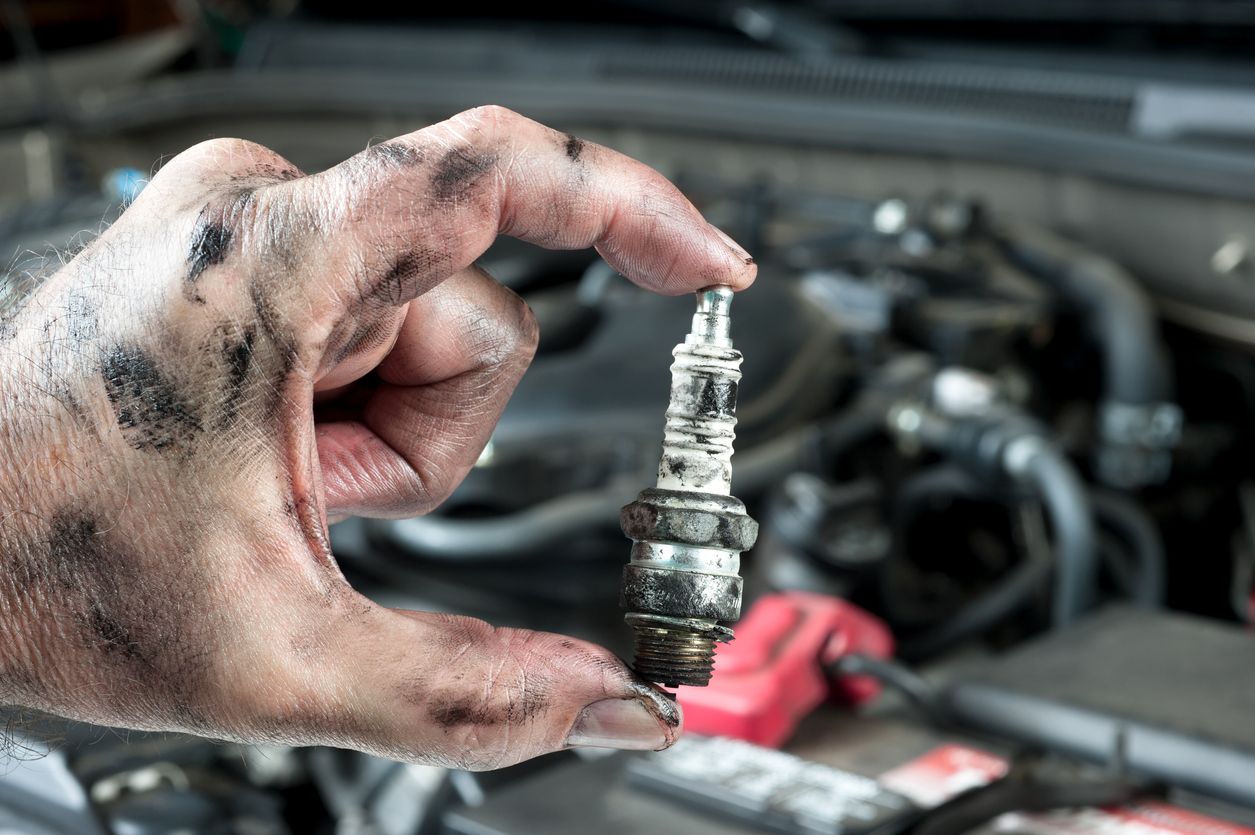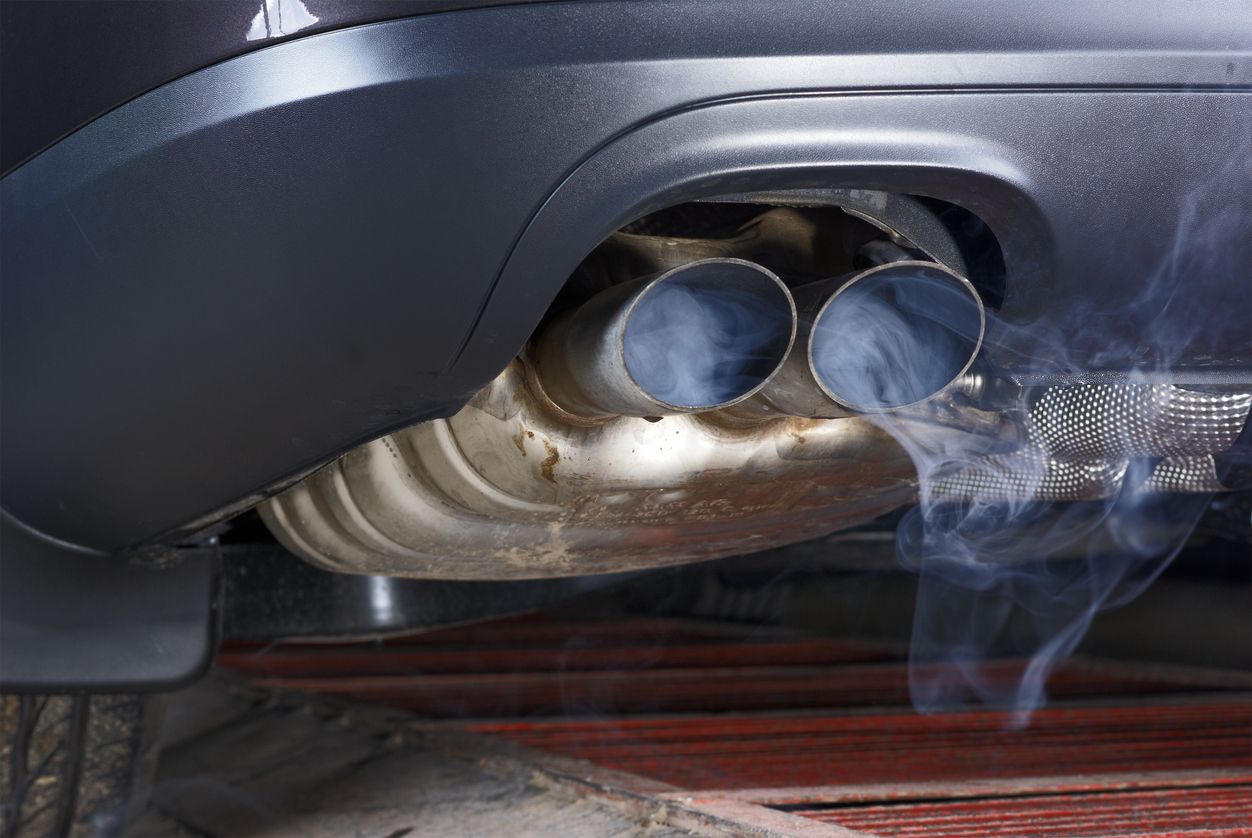If you've ever seen steam rising from your hood or a temperature gauge creeping into the red, you know how stressful an overheating engine can be. Whether you're stuck in traffic or cruising on the highway, knowing what to do when your engine overheats—and what not to do—may help keep you safe and save you from costly repairs.
- Signs your engine is overheating
- What to do when your engine overheats
- What not to do when your car engine overheats
- Why engines overheat
- How to prevent an overheated car engine
SIGNS YOUR ENGINE IS OVERHEATING
If you’re able to take steps to cool your engine before it overheats to the point of failing, you may reduce the risk of irreversible engine damage. But first, it's important to know the symptoms of an overheated engine, which can include:
- Temperature Gauge in the Red: Your first alert is an engine temperature gauge on your dashboard that spikes to "H" or into the red. (Engine temperature gauge symbols vary, so consult your owner's manual.)
- Steam (which can look like smoke) from the Hood: Steam is often a sign of boiling coolant escaping from the radiator or overflow tank. However, smoke—especially if it has a burnt or oily smell—could indicate oil or fluid leaks or other engine problems.
- Strange Smells: Sweet (coolant), burning rubber (belts), or hot oil smells could all point to overheating.
- Loss of Engine Power: The engine may run rough, stall, or go into limp mode to prevent damage.
- Dashboard Warning Lights: Some vehicles may display a temperature warning light or check engine light.
Don’t ignore these signs. The earlier you act, the better your chance of avoiding serious repairs.
WHAT TO DO WHEN YOUR ENGINE OVERHEATS
1. KILL THE AIR CONDITIONER AND CRANK THE HEAT.
Immediately turn off the A/C to reduce stress on the engine. Then, turn the dial to maximum heat. This may sound strange, but turning on the heat pulls hot air away from the engine and into the cabin, which can help reduce engine temperature. You may get a little hot yourself, but a few minutes of discomfort is a small price to pay compared to major engine repairs.
2. FIND A SAFE PLACE TO PULL OVER.
As soon as it’s safe, pull over and shut off the engine. Allow the engine to cool for at least 15-30 minutes before attempting to open the hood.
3. LET THE ENGINE COOL
Touching a hot radiator cap or engine component can result in serious burns. To ensure your vehicle has cooled down, keep an eye on the temperature gauge. It should move back to a normal range as the engine cools. (Remember that “normal” operating temperatures for coolant are still very hot for humans - DO NOT TOUCH)
While you're waiting (and watching the gauge), put together a plan to get your overheated engine checked out. You may contact a friend, roadside assistance, or call for a tow truck.
Note: Restarting the engine before it has cooled can cause further overheating or even permanent damage. If you need to check the engine temperature, only turn the ignition to the “on” position without starting the engine to read the gauge.
4. CHECK COOLANT LEVELS
Once the engine has cooled, visually inspect the coolant reservoir. If the level is low and you have coolant available, you may carefully top it off—but only after a few hours if the engine has cooled completely (the temperature gauge shows “cool”—not “normal”).
5. RESTART THE ENGINE.
If your car isn't being towed, now's the time to carefully restart your engine and drive to your nearest auto repair shop. Keep an eye on the temperature gauge as you drive. If it rises again, pull over and let the system cool.
WHAT NOT TO DO WHEN YOUR CAR ENGINE OVERHEATS
1. DON'T PANIC.
Your engine isn’t keeping its cool, but you can! Avoid swerving through traffic or slamming on your brakes when pulling off the road.
2. DON'T KEEP DRIVING.
If your engine is overheating but still running, you're not doing it any favors by continuing to drive. Driving while the engine is overheating can warp cylinder heads, crack the engine block, and cause irreparable damage.
Sure, you may be able to get to your destination before it gives out entirely, but pushing your engine too far may cause significant (and costly) damage.
3. DON’T OPEN THE HOOD IMMEDIATELY.
Once you've pulled over, wait for the engine to cool before popping the hood to check things out. Opening the hood immediately can put you at risk of burns or injuries from spewing steam or smoke. Patience is key. Wait until the engine temperature gauge settles before opening the hood.
4. DON’T POUR COLD WATER ON A HOT ENGINE
The sudden temperature change could cause parts of the engine to crack.
5. DON’T LET THE ISSUE LINGER.
An overheating engine won't resolve itself, even if it seems to be fixed after you add a little coolant. It will only get worse if left unaddressed. To help save your engine, get to the root of the issue. Bring your car to Firestone Complete Auto Care for a Complete Vehicle Inspection and so we can diagnose the problem and make recommendations for solving it.
WHY DO ENGINES OVERHEAT? 5 POSSIBLE CAUSES
What causes engine overheating? In general, it's because something's wrong within the cooling system, and heat isn't able to escape the engine compartment. The source of the issue could include low coolant levels, a cooling system leak, a bad radiator fan, a faulty water pump, low engine oil levels, or thermostat failure. Regardless of the problem's source, an overheating engine isn't something you want to let linger. Your engine could sustain serious, if not permanent, damage.
If you're wondering what can cause a car to overheat, here are a few possible culprits.
1. LOW COOLANT LEVELS
Coolant—a mixture of antifreeze and water at the correct ratio—absorbs heat from the engine and transfers it to the radiator, where it’s cooled by airflow. If the coolant level is too low—due to a leak, evaporation, or neglect—there isn’t enough fluid to manage engine temperature.
2. COOLING SYSTEM LEAK
A car’s cooling system is in charge of regulating heat coming from the engine. When coolant leaks from the system, the temperature of your engine will climb and, eventually, overheat.
A coolant leak can result from a faulty hose, worn-out gasket, cracked engine block, or even damaged radiator. Regular inspections and maintenance are the best ways to avoid coolant leak issues and damage from an overheated engine.
3. FAULTY WATER PUMP
Coolant doesn’t circulate all on its own. A car’s coolant system uses a water pump to push coolant around the working engine. So, when the water pump goes kaput, it can disrupt the coolant flow and lead to overheating.
One part to watch out for is a water pump’s impeller, a spinning fan-like component that pushes coolant through the passages of the cooling system. Problems arise when an old or worn-down impeller gets blocked or stops rotating altogether. And without the flow of coolant, your engine temperature can skyrocket fast. When a water pump fails in this way, it will need to be replaced.
3. DAMAGED OR LEAKING HOSES AND BELTS
Belts and hoses connect key components of the cooling system. Hoses move coolant to and from the engine and radiator, while belts help drive the water pump. Cracked, brittle, or loose hoses can leak coolant, and a broken belt can stop the water pump from working altogether. Either issue disrupts the flow of coolant, causing the engine to overheat.
3. BAD RADIATOR
When it comes to your vehicle’s cooling system, think of the radiator as the command center. A coolant mixture is constantly circulated from the radiator to the engine to absorb excess heat. When the coolant returns to the radiator, a series of fins cools it down and extracts heat from the coolant mixture.
How can a radiator go bad? Blocked passages can cut off the flow of coolant, so heat can’t transfer away from the engine. Damaged or bent radiator fins can make it more difficult for the radiator to extract heat from the returning coolant. And finally, a leak in the radiator can drain the system of coolant, which is the lifeblood of your vehicle’s cooling system.
4. LOW ENGINE OIL LEVEL
Car engines use many moving parts to ignite fuel that gets your vehicle moving. Engine oil provides essential lubrication to many engine components to reduce heat-generating friction. When engine oil levels are too low, poorly lubricated parts will create more friction and build up heat. In addition, engine oil also helps transfer heat away from the engine—just like coolant. Heat stress and even serious engine damage can result from low engine oil levels.
Staying on top of regular engine oil changes is the best way to avoid this problem altogether. Take indicators seriously, like your dashboard oil light, and get your car to a technician as soon as possible if you think your engine oil levels are too low. Better safe than sorry!
5. THERMOSTAT FAILURE
Your vehicle’s cooling system relies on a thermostat near the engine to determine when to send out coolant to regulate the engine’s heat. If you have a malfunctioning thermostat, the entire system can be thrown out of balance. If the thermostat fails to detect high temperatures, it will hold up the flow of coolant, and your engine will overheat.
On the flip side, if the thermostat has failed and is allowing coolant to flow constantly, your engine will have a hard time getting to operating temperature. The best way to avoid this is with regular cooling system maintenance, including coolant fluid exchanges as per the manufacturer's recommendations.
Any of these issues can cause your temperature gauge to spike and lead to rapid overheating. If you’ve ever asked yourself, "Why is my car overheating?"—there’s a good chance it traces back to one of these components.
HOW TO PREVENT AN OVERHEATED CAR ENGINE
Take care of your car, and it’ll take care of you. The best way to prevent an overheating car engine is to have regular inspections and coolant exchanges performed on your car and stay up-to-date with radiator maintenance as recommended by your vehicle manufacturer. Routine inspections can also help you fix any potential radiator or engine issues before they worsen.
Here’s how to prevent engine overheating with simple proactive steps:
- Check Coolant Levels Regularly: Top off when needed, and inspect for leaks.
- Inspect Your Cooling System and Radiator Regularly: During routine maintenance, have your cooling system, including hoses and the radiator, checked for leaks, clogs, and damage.
- Inspect Belts and Hoses: Look for signs of wear, cracking, or bulging.
- Watch for Warning Signs: Address unusual noises, smells, or dashboard indicators promptly.
- Schedule Regular Maintenance: A trained technician can catch issues before they become problems.
This summer, feel the heat at the beach, not on the road. Keep your cool and head to your nearest Firestone Complete Auto Care for the nationally trusted auto repair advice and service you need.



